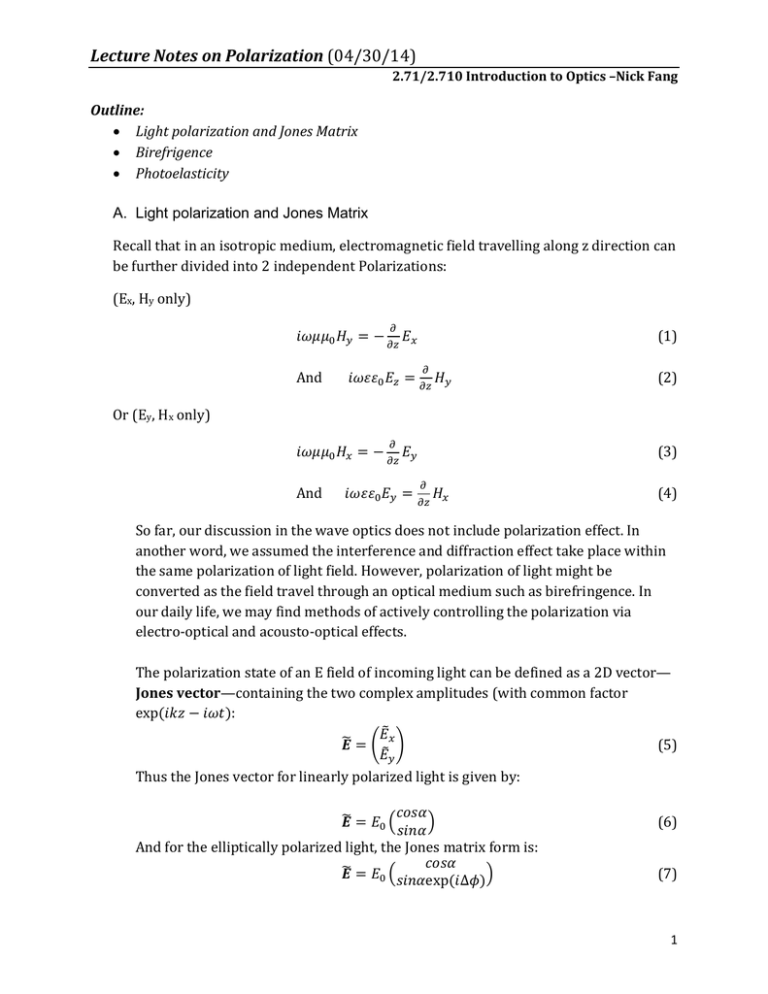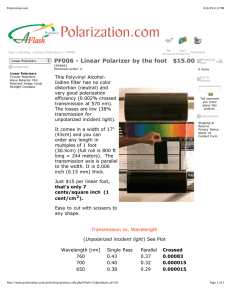
Lecture Notes on Polarization (04/30/14)
2.71/2.710 Introduction to Optics –Nick Fang
Outline:
Light polarization and Jones Matrix
Birefrigence
Photoelasticity
A. Light polarization and Jones Matrix
Recall that in an isotropic medium, electromagnetic field travelling along z direction can
be further divided into 2 independent Polarizations:
(Ex, Hy only)
𝜕
𝑖𝜔𝜇𝜇0 𝐻𝑦 = − 𝜕𝑧 𝐸𝑥
And
(1)
𝜕
𝑖𝜔𝜀𝜀0 𝐸𝑧 = 𝜕𝑧 𝐻𝑦
(2)
Or (Ey, Hx only)
𝜕
𝑖𝜔𝜇𝜇0 𝐻𝑥 = − 𝜕𝑧 𝐸𝑦
And
(3)
𝜕
𝑖𝜔𝜀𝜀0 𝐸𝑦 = 𝜕𝑧 𝐻𝑥
(4)
So far, our discussion in the wave optics does not include polarization effect. In
another word, we assumed the interference and diffraction effect take place within
the same polarization of light field. However, polarization of light might be
converted as the field travel through an optical medium such as birefringence. In
our daily life, we may find methods of actively controlling the polarization via
electro-optical and acousto-optical effects.
The polarization state of an E field of incoming light can be defined as a 2D vector—
Jones vector—containing the two complex amplitudes (with common factor
exp(𝑖𝑘𝑧 − 𝑖𝜔𝑡):
𝐸̃
̃ = ( 𝑥)
(5)
𝑬
𝐸̃𝑦
Thus the Jones vector for linearly polarized light is given by:
̃ = 𝐸0 (𝑐𝑜𝑠𝛼)
𝑬
𝑠𝑖𝑛𝛼
And for the elliptically polarized light, the Jones matrix form is:
𝑐𝑜𝑠𝛼
̃ = 𝐸0 (
𝑬
𝑠𝑖𝑛𝛼exp(𝑖∆𝜙))
(6)
(7)
1
Lecture Notes on Polarization (04/30/14)
2.71/2.710 Introduction to Optics –Nick Fang
© Pearson Prentice Hall. All rights reserved. This content is excluded from our
Creative Commons license. For more information, see http://ocw.mit.edu/fairuse.
Figure 14.4 of Pedrotti: Lissajous Figures of light polarization, Δ𝜙 = 𝜙𝑦 − 𝜙𝑥
Similarly, Jones matrices are used to model the effect of a medium on light's
polarization state.
̃ 𝑜𝑢𝑡 = 𝑀𝑬
̃ 𝑖𝑛
𝑬
(8)
Example: Wire grid polarizer
Input light
contains both
polarizations
© Source unknown. All rights reserved. This content is excluded from our Creative
Commons license. For more information, see http://ocw.mit.edu/fairuse.
The light can excite electrons to move along the wires, which then emit light that
cancels the input light. This cannot happen to light field perpendicular to the wires.
Such polarizers work best in the visible to IR wavelength.
2
Lecture Notes on Polarization (04/30/14)
2.71/2.710 Introduction to Optics –Nick Fang
̃ 𝑜𝑢𝑡 = (𝐸̃𝑥 ), regardless of the input
In this case, the polarizer gives an output field 𝑬
0
(random polarization). Therefore the Jones matrix of this x-polarizer is:
1
𝑀=[
0
0
]
0
(9)
B. Birefringence
Crystal materials often exhibit birefringence or known as double refraction. This is
because the anisotropic atomic structure of the lattice can respond to different
polarization of light waves, giving rise to anisotropic index of refraction at a given
frequency range. Due to Snell's Law, light of different polarizations will bend by
different amounts at an interface.
ny(w)
ny
1
w
nx(w)
The x- and ypolarizations can see
different resonances
and hence different
refractive index
curves.
© Source unknown. All rights reserved.
This content is excluded from our Creative
Commons license. For more information,
see http://ocw.mit.edu/fairuse.
nx
1
w0y
w0x
w
Uniaxial crystals have one refractive index for light polarized along the optic
axis(ne) and another for light polarized in either of the two directions perpendicular
to it (no). Light polarized along the optic axis is called the extraordinary ray, and
light polarized perpendicular to it is called the ordinary ray. These polarization
directions are the crystal principal axes. For example, calcite is one of the most
birefringent materials known in the world.(n0=1.6584, ne=1.4864@589.3nm)
3
Lecture Notes on Polarization (04/30/14)
2.71/2.710 Introduction to Optics –Nick Fang
The properties of double refraction are often used
for application of wave plates or retarders. For
example, a quarter-wave plate can be used to
convert a linearly polarized light beam to a
circularly polarized light.
In order to compensate the phase difference, two
sliding wedges made of the uniaxial crystals are
often used to vary the thickness.
Δ𝜙 =
2𝜋𝑑
𝜆
(𝑛𝑒 − 𝑛𝑜 )
(10)
© Pearson Prentice Hall. All rights reserved.
This content is excluded from our Creative Commons
license. For more information, see http://ocw.mit.edu/fairuse.
Exercise:
For quartz at wavelength of 589nm, ne=1.5533, no=1.5442. Let’s estimate
the following two cases:
(a) Minimum thickness of the quartz window to be used as quarter wave
plate;
(b) The thickness of the quartz window when the phase shift is (200+1/4).
C. Photoelasticity:
Polymers can make efficient polarizers, as partial alignment of the long chain
polymer molecules can cause birefringence. In fact, this is often used to measure
stress distribution of a plastic element, as you will see a quite beautiful display of
colors as you place these samples between two crossed linear polarizers.
4
Lecture Notes on Polarization (04/30/14)
2.71/2.710 Introduction to Optics –Nick Fang
Image of plastic protractor removed due to copyright restrictions.
Example of Photoelasticity: a plastic protractor placed between two crossed
polarizers. (Source: Wikipedia;
http://en.wikipedia.org/wiki/File:Plastic_Protractor_Polarized_05375.jpg )
For convenience, let’s set the optic axis of the (stressed) plastic in the y-direction,
and the Jones matrix of a thin slab of the plastic is given by:
1
0
M=[
]
(11)
0 exp(𝑖Δ𝜙)
For a pair of polarizers placed at ±45𝑜 , the transmitted E field can be
expressed as:
0
𝐸̃
1 −1 1
1
𝐸̃𝑜𝑢𝑡 = 0 [
][
]( )
2√2 −1
1 0 exp(𝑖Δ𝜙) 1
𝐸̃0 (1−exp(𝑖Δ𝜙)) 1
𝐸̃𝑜𝑢𝑡 =
( )
2√2
−1
The intensity is given by
Δ𝜙
1−exp(𝑖Δ𝜙) 2
𝐼∝|
| = 𝑠𝑖𝑛2 ( )
2
2
(12)
(13)
(14)
This element works as a compact Fabry-Perot interferometer!
Note: If you are interested in converting the measured phase difference to quantitative
stress maps, please read the section “Photoelasticity,” by Krishnamurthi Ramesh, in
Springer Handbook of Experimental Solid Mechanics, 2008”.
5
MIT OpenCourseWare
http://ocw.mit.edu
2SWLFV
Spring 2014
For information about citing these materials or our Terms of Use, visit: http://ocw.mit.edu/terms.






